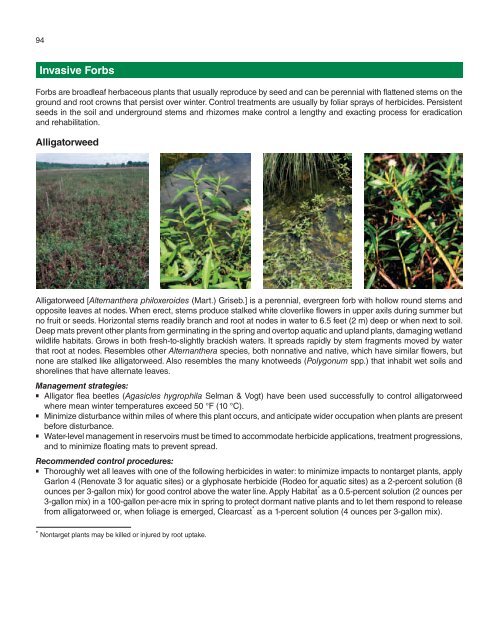A Management Guide for Invasive Plants in Southern Forests James ...
A Management Guide for Invasive Plants in Southern Forests James ...
A Management Guide for Invasive Plants in Southern Forests James ...
- No tags were found...
Create successful ePaper yourself
Turn your PDF publications into a flip-book with our unique Google optimized e-Paper software.
94<strong>Invasive</strong> ForbsForbs are broadleaf herbaceous plants that usually reproduce by seed and can be perennial with flattened stems on theground and root crowns that persist over w<strong>in</strong>ter. Control treatments are usually by foliar sprays of herbicides. Persistentseeds <strong>in</strong> the soil and underground stems and rhizomes make control a lengthy and exact<strong>in</strong>g process <strong>for</strong> eradicationand rehabilitation.AlligatorweedAlligatorweed [Alternanthera philoxeroides (Mart.) Griseb.] is a perennial, evergreen <strong>for</strong>b with hollow round stems andopposite leaves at nodes. When erect, stems produce stalked white cloverlike flowers <strong>in</strong> upper axils dur<strong>in</strong>g summer butno fruit or seeds. Horizontal stems readily branch and root at nodes <strong>in</strong> water to 6.5 feet (2 m) deep or when next to soil.Deep mats prevent other plants from germ<strong>in</strong>at<strong>in</strong>g <strong>in</strong> the spr<strong>in</strong>g and overtop aquatic and upland plants, damag<strong>in</strong>g wetlandwildlife habitats. Grows <strong>in</strong> both fresh-to-slightly brackish waters. It spreads rapidly by stem fragments moved by waterthat root at nodes. Resembles other Alternanthera species, both nonnative and native, which have similar flowers, butnone are stalked like alligatorweed. Also resembles the many knotweeds (Polygonum spp.) that <strong>in</strong>habit wet soils andshorel<strong>in</strong>es that have alternate leaves.<strong>Management</strong> strategies:Alligator flea beetles (Agasicles hygrophila Selman & Vogt) have been used successfully to control alligatorweedwhere mean w<strong>in</strong>ter temperatures exceed 50 °F (10 °C).M<strong>in</strong>imize disturbance with<strong>in</strong> miles of where this plant occurs, and anticipate wider occupation when plants are presentbe<strong>for</strong>e disturbance.Water-level management <strong>in</strong> reservoirs must be timed to accommodate herbicide applications, treatment progressions,and to m<strong>in</strong>imize float<strong>in</strong>g mats to prevent spread.Recommended control procedures:Thoroughly wet all leaves with one of the follow<strong>in</strong>g herbicides <strong>in</strong> water: to m<strong>in</strong>imize impacts to nontarget plants, applyGarlon 4 (Renovate 3 <strong>for</strong> aquatic sites) or a glyphosate herbicide (Rodeo <strong>for</strong> aquatic sites) as a 2-percent solution (8ounces per 3-gallon mix) <strong>for</strong> good control above the water l<strong>in</strong>e. Apply Habitat * as a 0.5-percent solution (2 ounces per3-gallon mix) <strong>in</strong> a 100-gallon per-acre mix <strong>in</strong> spr<strong>in</strong>g to protect dormant native plants and to let them respond to releasefrom alligatorweed or, when foliage is emerged, Clearcast * as a 1-percent solution (4 ounces per 3-gallon mix).* Nontarget plants may be killed or <strong>in</strong>jured by root uptake.
















